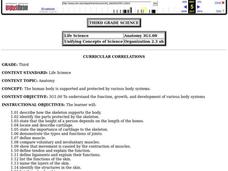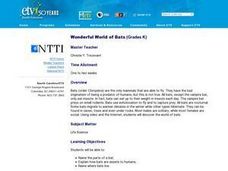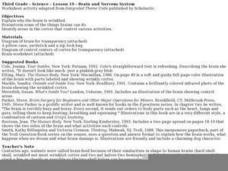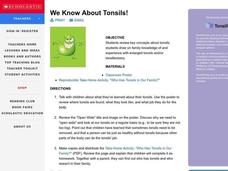Curated OER
Pacific Salmon and Mountain Pine Beetle
Learners compare fish anatomy. For this teacher demonstrated dissection lesson, students compare fish anatomy to that of humans. They explore different fish and their unique properties. There are 4 distinct activities which can be...
Curated OER
It's Challenging Being Green!
Students influence the plant life cycle as they take care of plants.In this caring for plants lesson plan, students understand the parts of the plant and their functions in keeping it alive. Students participate in experiments with...
Curated OER
Insect Body Parts and their Functions
Students explore all the parts of an insects body and assess their specific functions. They review an extensive vocabulary list of terms and then relate the parts of an insect to those of a human being. Dragonfly Poetry is also taught...
Curated OER
MICROBES 1: WHAT'S BUGGIN YOU?
Middle schoolers use existing knowledge of microbes, focusing on the relationship between microorganisms and foodborne illness, as well as the implications that foodborne illness has on human health.
Curated OER
Skeletal System
Third graders describe and identify the parts of the skeleton and how they support the body. They observe two chicken bones that have been soaked in vinegar for 5 - 7 days. They observe the bone's appearance after it has been removed...
Curated OER
Cells All Around
Young scholars measure the size of an epithelial cell and to estimate the number of epithelial cells in a given area of the body. After watching a video on cells, student groups perform an experiment using a microscope to view some of...
Curated OER
Starfish
Young scholars explore the concept of starfish. For this starfish lesson, students identify the parts of a starfish and how their body works. Young scholars create a starfish using paint and a cornmeal mixture. They then glue...
Curated OER
So You Think You're Tough
Fourth graders learn how to classify animals. In this invertebrates lesson, 4th graders discuss how we classify thinks into groups and move into a discussion about classifying animals. Students learn about the differences between...
Curated OER
Wonderful World of Bats
Students create a book about bats. They write a letter to a scientist containing questions about bats. They compare the socialization of bats to humans; compare the needs of bats to humans and other animals.
Curated OER
"ART ZOO 'Blacks in the Westward Movement', 'What Can You Do with a Portrait', and 'Of Beetles, Worms, and Leaves of Grass'"
Students study black history, examine portraits and portrait making and create their own portraits, and investigate their natural environment. This humanities lesson provides a text that can be used to teach lessons in black...
Curated OER
Talking 'Bout Regeneration
Students research the regenerative capabilities of certain organisms. They present their findings at a student regeneration symposium aimed at exploring the possibilities of human regeneration.
Curated OER
Standard 4 Review Sheet-Key Ideas Biology-The Living Environment
In this living environment worksheet, young scholars answer a variety of questions about living organisms, the processes they go through to make food and break down food, absorb nutrients, and release toxins. They explain homeostasis,...
Curated OER
Plants and Animals, Partners in Pollination
Students participate in multiple hands-on activities to explore reproduction and pollination. In groups, using a cotton swab and powder, students simulate being pollinators and plants. They name the parts of the flowers and the function...
Curated OER
Cardiac Arrest! Using Forensics to Investigate Cardiovascular Anatomy and Function
Students identify the different parts and functions of the cardiovascular system. In this forensics lesson, students collect and analyze evidence on a fictional crime. They describe different causes of cardiac arrest.
Curated OER
Squid Dissection
First graders participate in dissecting a squid. They identify and locate specific parts of a squid with teacher guidance. They draw a picture of what their squid looked like and label specific parts.
Curated OER
North, South, East, and West
A basic lesson on the teaching of the cardinal directions awaits your class. They are directed to go to different parts of the playground and where they attempt to describe their location in relation to each other by using the cardinal...
Curated OER
Cooperative Learning Games
Pupils create a human obstacle course by making obstacles using their bodies. They work with a rope to have all students pass under it without using their hands to hold or move it. They complete a list of challenges in which the...
Curated OER
Ya' Gotta Have Heart
Fourth graders study the parts of the human circulatory system and how they function. They design a flow chart of the circulatory system and use data to construct charts and graphs.
Curated OER
Reproduction, Day 1
Students identify the parts of the human body involved in reproduction. They examine the process of fertilization and discover all species reproduce. They practice using new vocabulary as well.
Curated OER
Brain and Nervous System
Third graders study the physical characteristics of the brain and identify its parts through this series of lessons.
Curated OER
We Know About Tonsils
Learners engage in a lesson that is concerned with the use of tonsils in the human body. They brainstorm in small groups to review the location and purpose of having tonsils. The teacher uses a poster to help students in the class...
Curated OER
Energy Content Of Foods And Fuels
Young scholars engage in a study of food and how it used as fuel for the human body. They research how biological systems require energy and compare them to the physical science systems like machines. They compare and contrast what they...
Curated OER
What Are Our Risks From Radon?
High schoolers discover the risks from radon. They examine a graph of what a low dose of radon will do to a human body and then discuss. They answer questions to complete the lesson.
Curated OER
Insects
Students work in groups to investigate the concept of insects. They participate in a variety of activities that include the gathering of samples and making observations like identifying different body parts. The lesson integrates...























